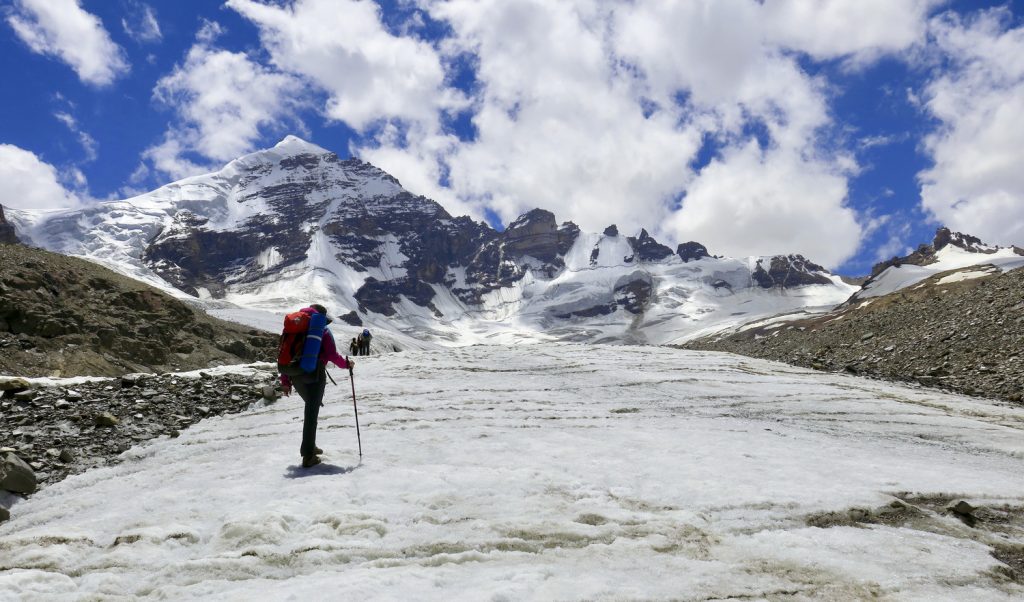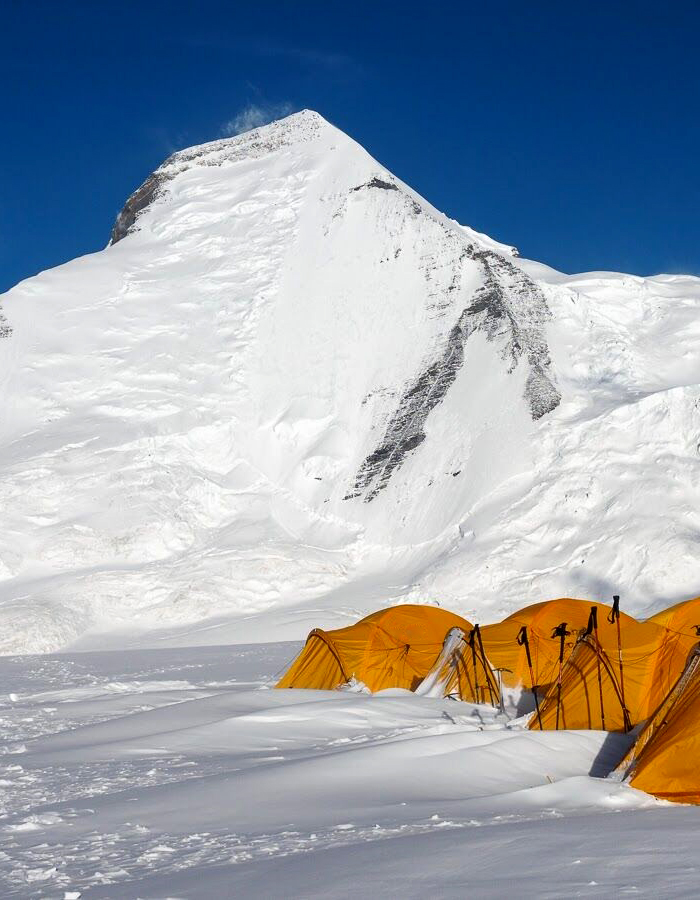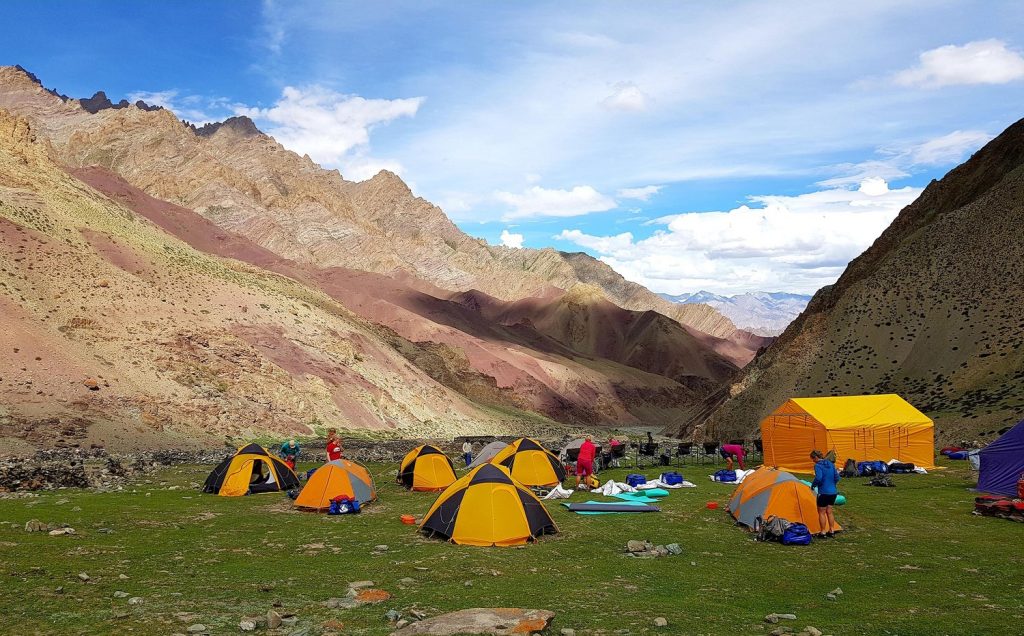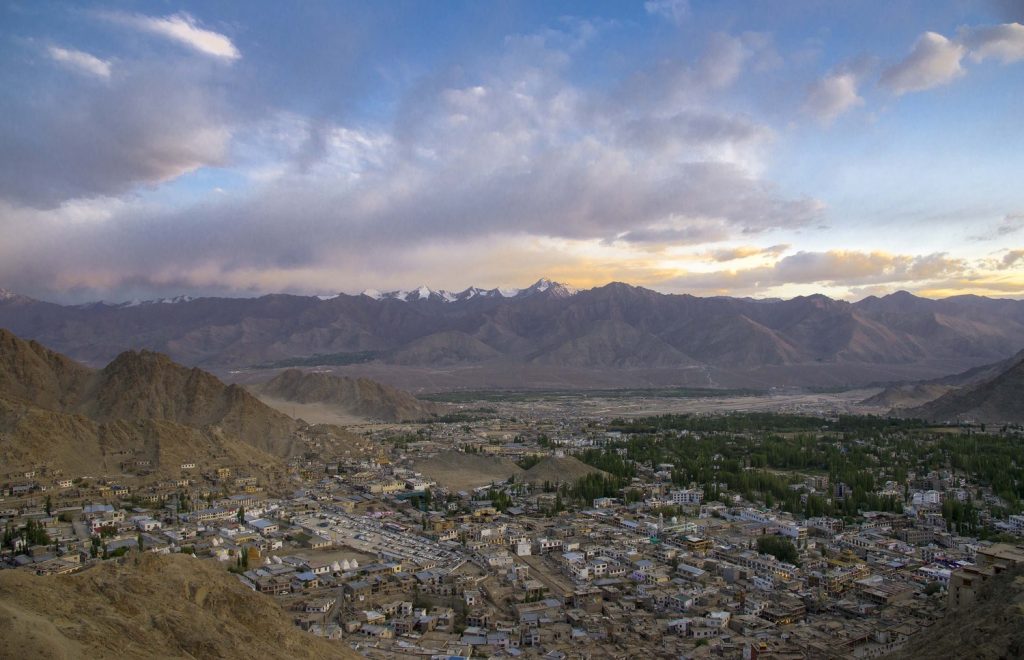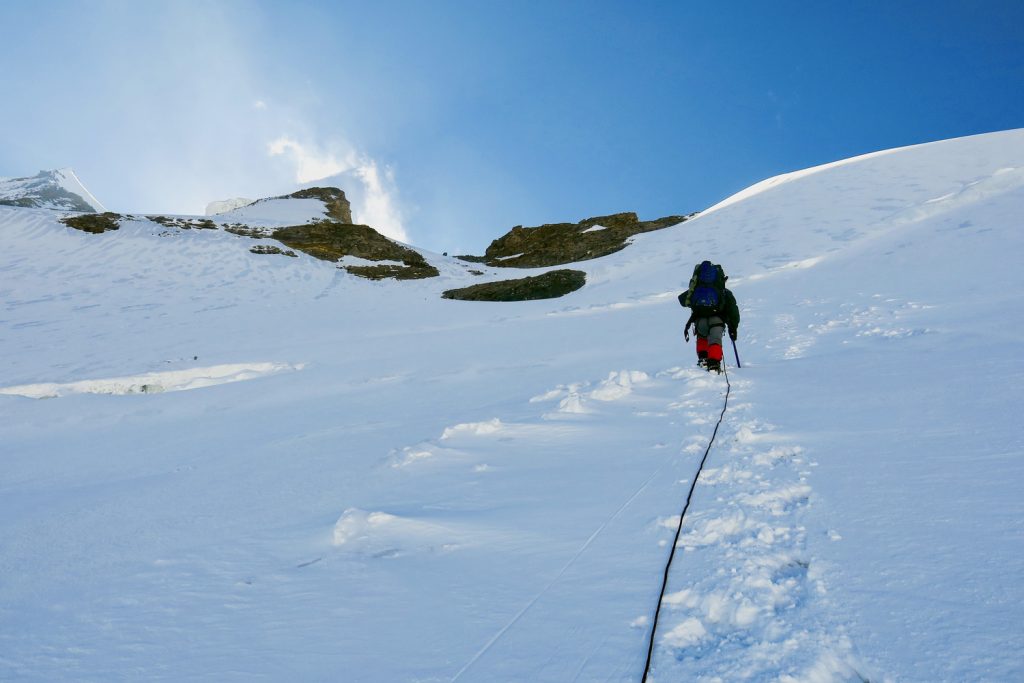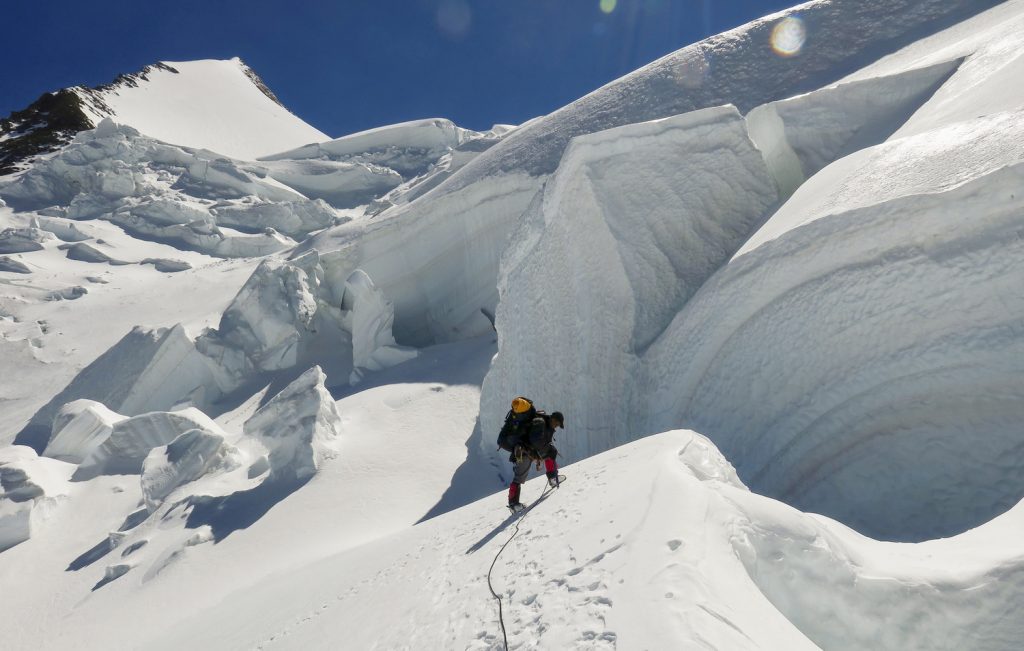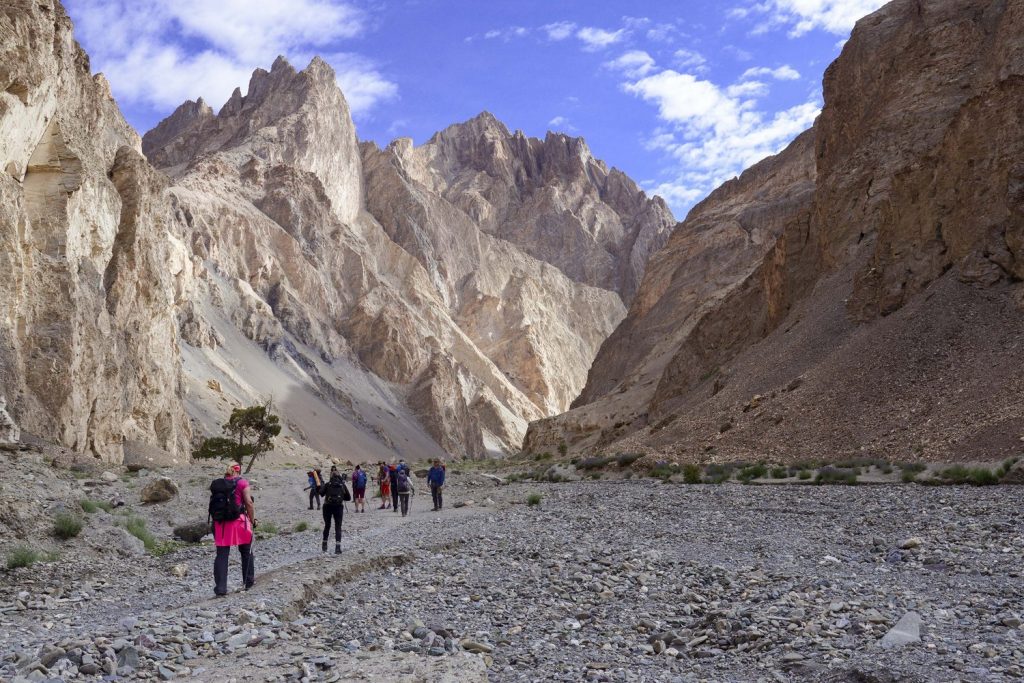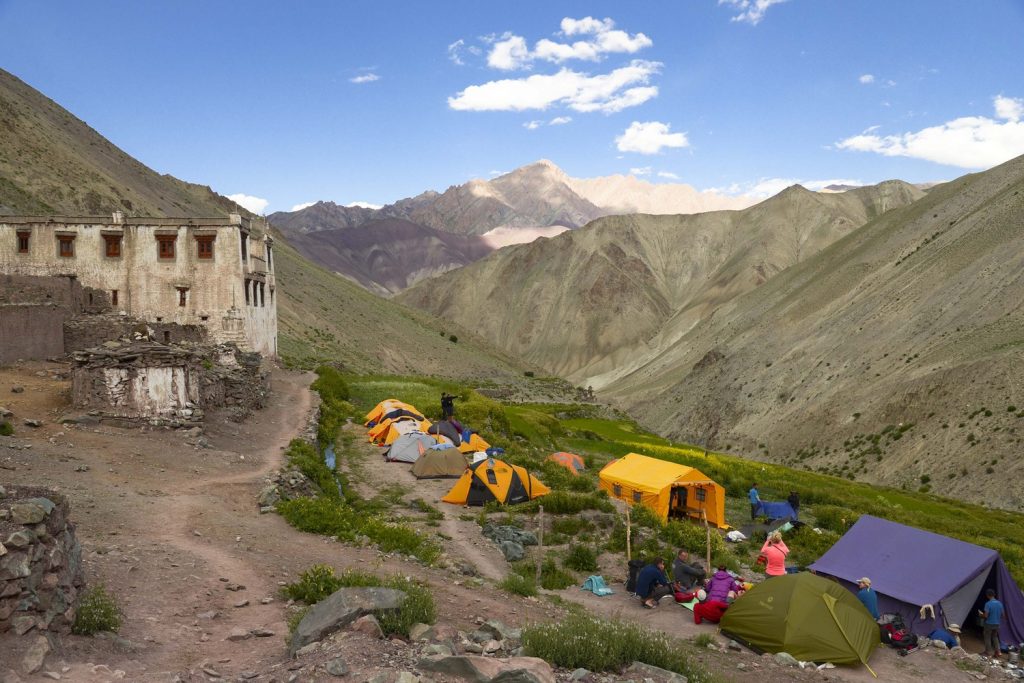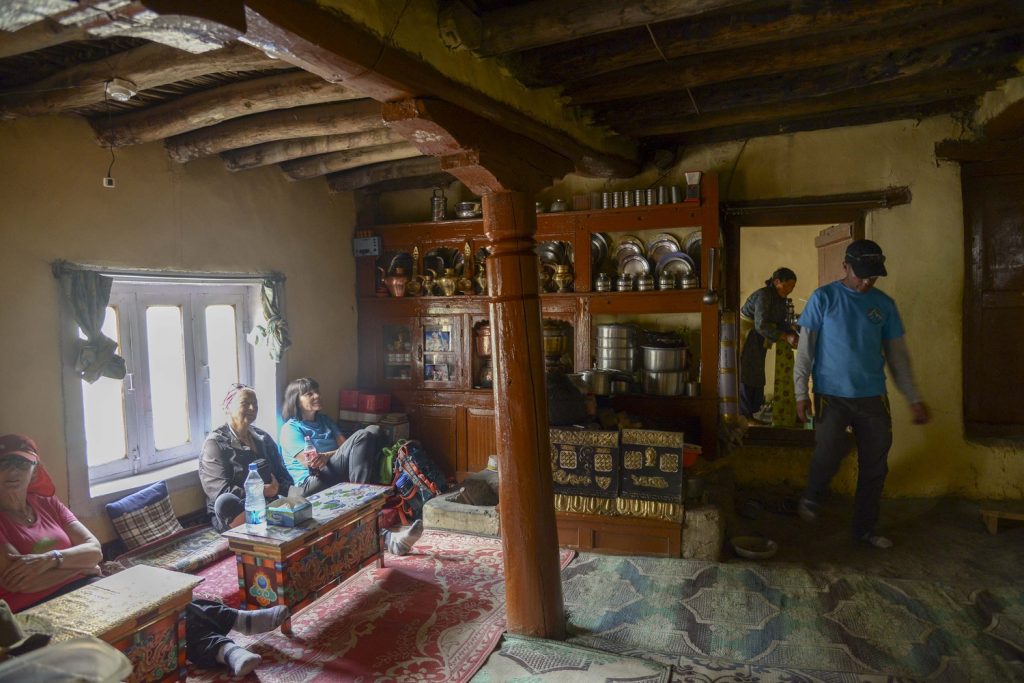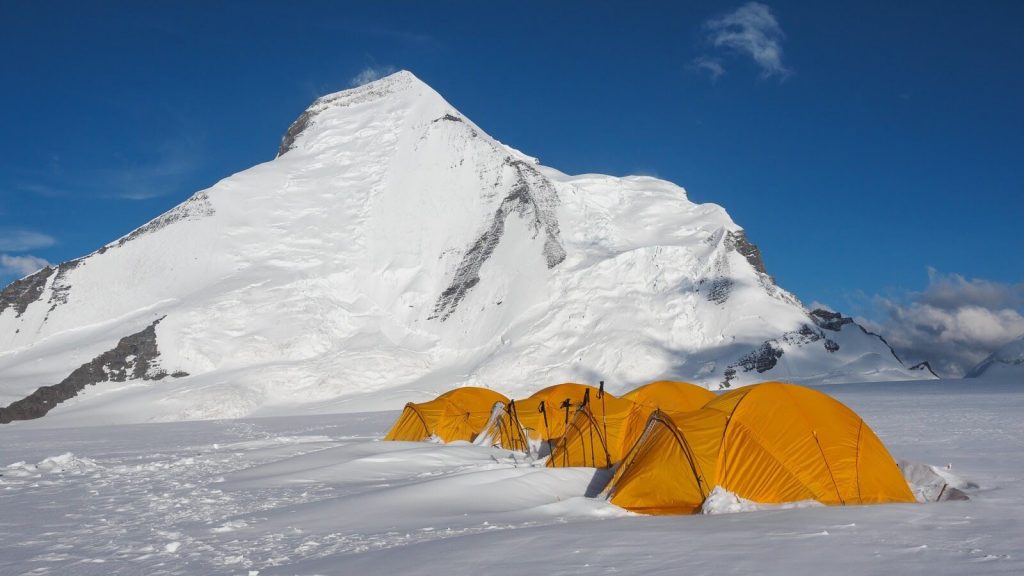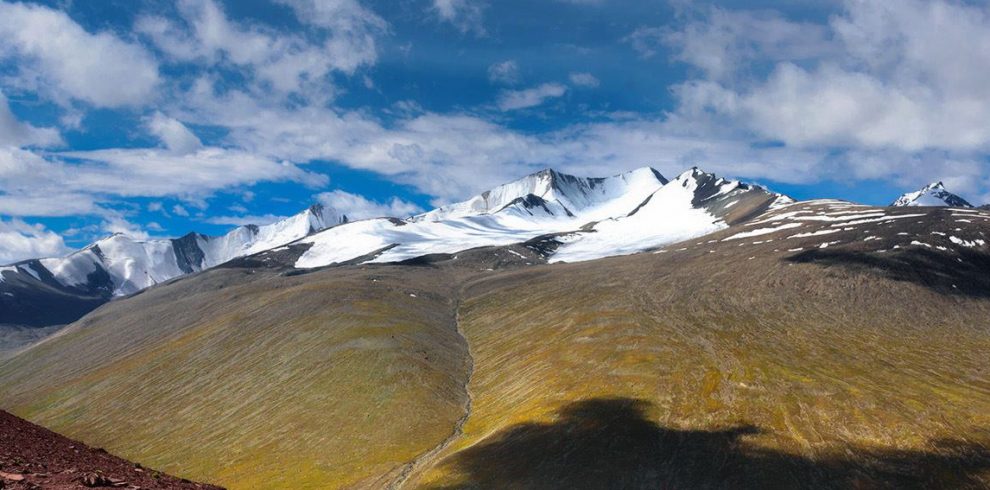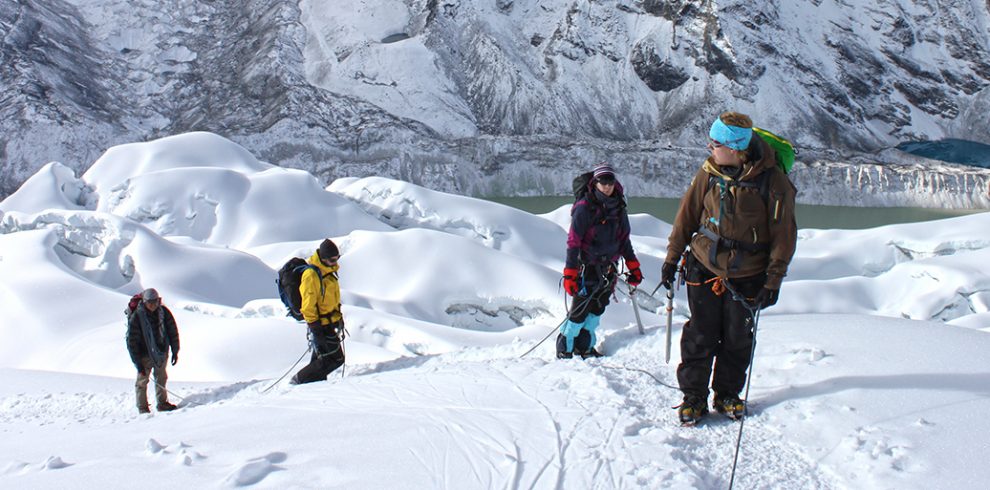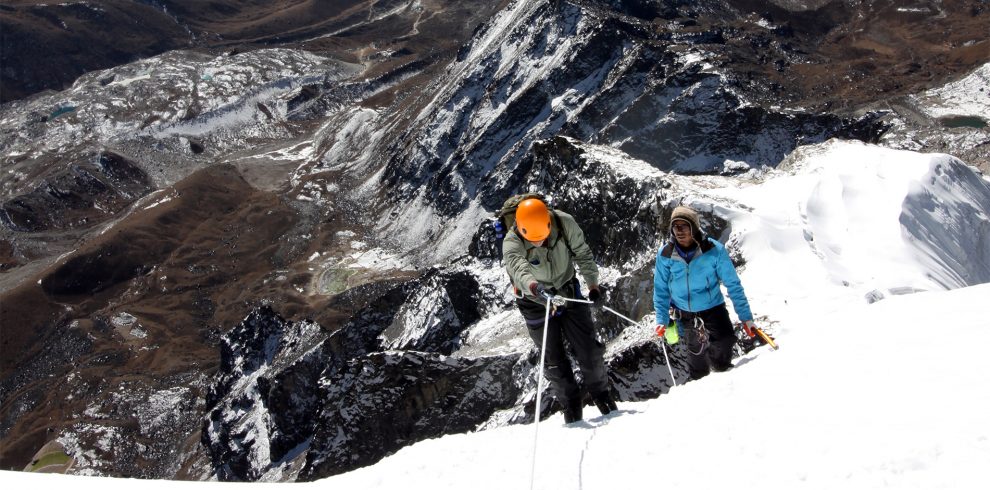Mt. Nun is the culmination of the Nun Kun mountain massif which comprises of two peaks: Mt. Nun, 7,135 m (23,409’) and its neighbour peak Mt. Kun, 7,077 m (23,218ft). These two peaks are separated by a snowy plateau of about 4 km in length. This Nun Kun massif is located near the Suru valley, about 250 km east of Srinagar, the capital of the Indian state of Jammu and Kashmir.
The first ascent of Nun was in 1953 by a French mountaineer Mrs. Claude Kogan and Mr. Pierre Vittoz, a Swiss missionary residing in Leh Ladakh.
The base camp of Mt. Nun is most conveniently accessed from the road connecting Kargil and Leh. The route to Base Camp starts at the head of the Shafat glacier which is at 4400m. The ascent is a moderate snow and ice route suitable for those with previous climbing experience of any of the 6000m trekking peaks in the Himalaya.
Summary of the Expedition
After arriving at New Delhi, team reports at the Indian Mountaineering Federation’s headquarters for the briefing of our Mt. Nun Expedition and meet with our Liaison Officers.
A 90 min scenic mountain flight flying above the Indian Himalaya brings us the Ladakhi capital of Leh. We spend a few days for sightseeing and acclimatizing around Leh, followed by four days of trek through Hemis National Park to acclimatize and tone up before our journey to the base camp of our mountain.
The journey to Nun Peak Base Camp begins with a drive through the Suru Valley. A 5 hour trek from the last village, Tangol, brings us to the base camp of Mt. Nun. A couple of rest days are utilized at Base Camp for acclimatization. Once settled, the acclimatization rotation begins to Camps 1 and 2 before finally setting up our Summit Camp at 6400m, during which higher camps are set up. The final Summit push begins with a traverse on 40° – 60° ice for about 300m to access the west ridge. After gaining the west ridge, the route follows the ridge on 300 m of 40° – 50° snow. We climb on fixed ropes as the summit ridge is fairly sharp. After summit, we return to Camp 3.
The next couple of days we utilize for packing up base camp and drive back to Leh, from where we fly out to New Delhi.
What makes this trip special
- Climb the highest peak in Zanskar and Kargil regions of Ladakh
- Semi-technical ascent to break the 7000m barrier
- Perfect training for future climbs to 8000 meter mountains.
- Travel to a remote section of the Himalaya- Buddhist culture, ancient monasteries, local cuisine, and historic townships along the ancient Silk Highway.
- Trek through Hemis National Park- the realm of the Snow Leopard
- Experience the magical landscapes of Ladakh
Itinerary
Altitude: 216m
On arrival to Indira Gandhi International Airport at New Delhi and finish with the immigration and custom formalities, our representative will meet you at the Main Exit with a Hi On Life Adventures placard. It is about 15 to 20 mins drive to the Aerocity where we have chosen your hotel for the practicality for the next days early morning domestic airport transfer. When you arrive at your hotel you will be briefed about your trek and “do’s and don’ts” while your stay in India. In the evening we will have a welcome dinner to begin the taste of India at one of the finest dining in New Delhi.
It is mandatory to meet the IMF officials before the start of the expedition. We will be appointed a Liaison Officer for our expedition group. The afternoon is free. We can arrange a sightseeing of Delhi if anyone is interested.
Altitude: 3500m Flight duration: 1 hour 25 mins
Early morning drive to the domestic airport to fly to Leh. Be prepared for an extensive security checks for your own safety owing to the fact that Leh is strategically located close to Pakistan and China. Baggage allowance Delhi-Leh is only 15kg per person, unless you have a through ticket on the same airline internationally. However, excess baggage charges are only $5 per kilo. It will be an early morning flight to Leh which is a fantastic mountain flight. The flight takes about 1 hour and 20 mins to Leh and approach to the airport at Leh is extremely scenic, so get your cameras ready. The airport at Leh is also an Indian Air Force Base, therefore it is heavily guarded and again extensive security checks. We will be received at the airport by a representative from Ladakh and will be transferred to our hotel. An important component of our trip that we must adhere to is the acclimatization required due to high altitude. Do not plan on heading out at all today. Rehydration is the key to cope up with the high altitude, so drink water regularly. We will take this first day at high altitude with leisure, maximum exertion should maybe be a small stroll outside to the neighboring shops.
Altitude: 3500m- 3100m
Sightseeing duration with drives: 6 to 7 hours
We begin with a 40 km drive to Hemis. The wealthiest monastery of Ladakh and India, Hemis Monastery belongs to the Drukpa lineage of Tibetan Buddhism. The monastery was re-established in 1672 by the Ladakhi king Sengge Namgyal. After visiting Hemis monastery, we will visit Thiksey monastery. Thiksey monastery is affiliated with the Gelug sect of Tibetan Buddhism. It is located on top of a hill in Thiksey approximately 19 kms east of Leh. It is noted for its resemblance to the Potala Palace in Lhasa, Tibet and is the largest monastery in central Ladakh.
After the sightseeing, we will drive back to our hotel. The rest of the afternoon is free.
Drive: 25 kms, 45 mins
Trek distance: 6.5 km, 3 hours
Elevation of Zingchen: 3400m
Elevation of Rumbak: 3950m
After breakfast we will drive to Zingchen via Spituk. It is an easy walk for 3 hours and we reach Rumbak. Rumbak is famous for being the home of the Snow Leopard during the mating time in the winter. During the winter we have Snow Leopard sighting tours when we camp here for a week. Upon arriving at Rumbak we will check in to a homestay. In the afternoon we can take a short stroll through the village.
Overnight homestay
Trek distance: 3 km, 2 hours
Elevation of Yurutse: 4148m
Today is a short day. we need to acclimatize gradually, and the next day we cross a 4960m pass, hence this short day. It is a steady climb from Rumbak to Yurutse.
Trek distance: 6 km, 5 to 6 hours
Elevation of Ganda La: 4960m
Elevation of Shingo: 4140m
From Yurutse the trail switchbacks steeply up to Ganda La. It takes about 3 hours to reach the top of the pass. There are beautiful views from the pass. After the pass, it is a gentle descend for 3 hours to reach Shingo where we stay at a homestay. We can spot several marmots along the way.
Trek distance: 14 km, 4 hours
Elevation of Chilling: 3370m
Drive Chilling to Alchi: 63 kms, 2 ½ hours
Elevation of Alchi: 3100m
It is an easy trek down to Skiu through narrow gorge and then an almost flat walk to Chilling. We will be picked up by our car at Chilling and then drive the first 28 Kms following the Zanskar river to a place called Sangam which is the confluence of the Zanskar and Indus rivers. Part of this road is gravel road. After Sangam we drive on Leh- Srinagar highway for 35 kms to reach Alchi.
Upon arrival to Alchi, we check in to our hotel.
Drive: 160 kms, 5 hours
Elevation of Kargil: 2670m
In the morning we can visit the beautiful monastery of Alchi and then continue to drive on Leh Srinagar highway to Kargil. On the way we will enter the “moonland” of Lamayuru. A unique landscape which looks like a glacier but made of sand is carved into the dry giving it moon like appearance. We can visit the Lamayuru gompa here. The town of Kargil served at one point of time as an important hub in the Pan-Asian trade network. Convoys to and from China, Tibet, and Kashmir carrying exquisite goods consisting of silk, brocade, carpets, tea, poppy, ivory, etc. regularly passed through Kargil.
Upon arrival at Kargil we will check in to our hotel.
Drive: 75 kms, 5 hours
Elevation of Tangol: 3700m
The drive is on partly gravel road towards the Suru Valley. Tangol is the last village connected by road and from here we get the first glimpse of our mountain Nun Peak.
Overnight Camp.
Trek: 12 kms, 6 hours
Elevation of Base Camp: 4600m
It is a moderate trek to Base Camp. The route initially goes through scree and rockfall area till a small col. After descending the col, we start climbing gradually on the lateral moraine of a glacier. Upon arrival we will establish our Base Camp.
Overnight Camp
We will utilize this day to organize our gears for the climb.
During this period, we will open routes and ferry loads and set up 3 camps (C1-5500m, C2-6100m & C3-6400m).We will make multiple ascends and descends to higher camps and back while acclimatizing during the process.
Base Camp to Camp 1 (5500m) 6 hours approx: Route starts with around 500 m ascent on scree slopes and the lateral moraine of Sentik glacier coming down from the Nun glacial plateau at 5500 m. From here After the scree and moraine slopes, the route follows the middle of the glacier for 200 m on 50° ice, then 200 m on 30° snow. This is followed by a 4 km glacier walk on a snow covered plateau just below the west ridge. Return to Base Camp for the night.
We will negotiate an icefall of 200 meters on 50° ice followed by another 200 m on 30° snow on fixed line.
Camp 1 to Camp 2 (6100m) 6 hours approx : The route from Camp 1 goes across the base of the mountain and continues up 600 vertical meters of mixed scree, rock, snow and ice between 30° and 50° on fixed rope.
Camp 2 to Camp 3 (6400m) 5 hours approx : The route from Camp 2 begins with a short scramble followed by a 250m ascent on shallow 30° snow leading to a rocky summit of a subsidiary peak. A short steep descend brings us to a col from where we ascend a short section of fixed ropes up ice slopes to a plateau at around 6400 meters. Camp 3 is located in an open area below the final summit peak of Nun.
Camp 3 to Summit (7153m) 10 hours approx: We start early for our summit attempt. The final summit push begins with a traverse of 300m towards the left of the mountain on 40° - 60° ice to access the west ridge. The west ridge continues 300m to the summit on 40° - 50° snow to the summit. The summit ridge is exposed which is climbed on fixed line all the way to the summit.
A five hour trek will bring us back to Tangol.
Overnight Camping
Today we drive for 5 hours back to Kargil. If the group agrees to handle a 10 hours drive then we can drive all the way back to Leh.
Overnight Hotel
You can utilize this day for strolling the markets of Leh and shopping.
Overnight hotel
Flight duration: 1 hour 25 min
Early morning drive to the airport to catch early morning flight to Delhi. Once again prepare for an extensive security checks. Lithium Batteries (eg spare camera batteries) – must be in your checked luggage for the return flight from Leh back to Delhi. On arrival to New Delhi we are transferred to our hotel.
You will be transferred to Indira Gandhi International airport 4 hours before your flight departure time.
Cost
Cost Includes
- All International and Domestic airport transfers in Private A/C vehicle
- All guided sightseeing tours in Delhi and Ladakh in Private A/C vehicles
- 5 Star hotel accommodations on BB plan on twin sharing basis in New Delhi
- Welcome dinner in one of the finest authentic Indian dining in Delhi
- 3 Star category hotel in Leh on full board
- All Camping and Monasteries entrance fees
- Wild life fee for the applicable area
- Nun Peak climbing permit.
- Liaison officer’s fees.
- Services of experienced Expedition Leader/ guide
- 1 Climbing Sherpa for every 2 members
- Cook and kitchen helpers
- Horses and mules for carrying bags and camping gears
- Full board home-stay trek with all meals while on pre-climb trek.
- All meals during the climb.
- Single tent with comfortable mattresses for each member while at Base Camp
- Hilleberg Saivo/ North face VE25/ Mountain Hardware tents on twin sharing while at higher camps.
- Kitchen tent, Dining tent and Toilet tents and shower tents
- Table Chairs and all Kitchen materials.
- All mountaineering equipment, including ropes, fixing gear, stoves and fuel,
- Radios and “walkie talkies”.
- Emergency use of Pressure bag (Gamow bag) and medical oxygen cylinders.
- Comprehensive medical kit
- Staff insurance, tourist service fee and all taxes applicable as per state law.
- Use of personal trekking pack consisting of a duffle bag, sleeping bag, sleeping bag liners, and down jacket.
- Hi On Life Adventures T shirt.
- Staff insurance and all applicable taxes
Cost Excludes
- Insurance: Travel/Accident/Medical /emergency evacuation
- Private room accommodation in Delhi and Leh unless a single supplement is paid.
- Staff tipping
- 250 USD/ member for Sherpa summit bonus.
- Indian Visa
- Telephone, laundry, mineral water, soft drinks and alcoholic beverages.
- Emergency rescue evacuation cost if needed
- All other personal nature expenses.
Location Map
About Ladakh
Ladakh, “The land of high passes”, is a region in the Indian state of Jammu and Kashmir. Although, rock carvings found in many parts of Ladakh indicate that the area has been inhabited from Neolithic times, not much is known about Ladakh before the 1st century. During the 2nd century when much of eastern Ladakh and western Tibet was still practicing the Bon religion, Buddhism started to spread into western Ladakh from Kashmir. In 842 Nyima-Gon, a Tibetan royal prince annexed Ladakh after the break-up of the Tibetan empire, and founded a separate Ladakhi dynasty. During this period, Ladakh acquired a predominantly Tibetan population. Also known as “Little Tibet” Ladakh’s culture and history are closely related to that of Tibet.
The largest town in Ladakh is Leh, followed by Kargil. Ladakhis are Tibetan-Mongoloid in appearance although traces of Kashmiri Moslem influence can also be seen. The predominant religion in Ladakh is the Tibetan form of Buddhism, although Islamic influences are found from the Kashmir Valley as far as Kargil, and there are some Christian families in Leh.
Some interesting facts about Ladakh
- Ladakh is the highest settlement in India. The fields at Korzok, on the Tso-moriri Lake, at 4,600m are widely considered to be the highest cultivated lands in the world.
- A Bailey bridge between the Suru River and Dras River in Ladakh, is the highest bridge in the world at an altitude of 5,602m.
- Only place in India where twin humped Bactrian camels can be found.
- Ladakh is home to the mystical Magnetic Hill, which is a so-called “gravity hill”. The alignment of the road with the slope of the background can give the illusion that cars are able to drift upwards.
- The Pangong lake in Ladakh is one of the highest salt lakes in the world
A Day on Your Trek
Although each day is different, considering the weather, general pace of the group and length of the days walk, in general your day begins with a wake up tea at around 6 to 6:30 in the morning. You will then be provided with a bowl of warm water for washing. Then you will need to pack your duffel bag and your day pack and come to the lodge’s dining for breakfast.
After breakfast we will hit the trail and usually walk for about 3 to 4 hours before we stop for lunch. We will give you about an hour and a half rest during lunch, which will also give enough time for the staff to have their lunch and pack. Usually after 3 to 4 hours of walking we finish the days walk by 4 PM. Tea/ Coffee and snacks will be served on arrival to the lodge. Your group Leader will often organize side trips in the afternoon. Your dinner will be served around 7 PM.
During camping at Base Camps: You will be sleeping in Tents and the food will be cooked and served in the dining tent by our staff. We will provide single tent with comfortable sleeping 3 inch foam mattress with insulated ridge mattress at base Camp. On higher camps we provide North Face VE 25 tents on twin sharing. We also have weather proof Kitchen and Dining tents with comfortable tables and chairs. Toilet tents with sitting pot and shower tent will be provided at Base Camp.
High Altitude
On this expedition you will be climbing a technical mountain which is 7135m, so it is very important to understand the effects of altitude. The greatest provocation is going too high too fast. Hi On Life’s itinerary has been carefully designed to minimize the effects of altitude. We ascend slowly and surely allowing enough time for safe acclimatization.
Headaches and breathlessness are common at altitude which in itself is nothing to worry about. In rare cases, this may worsen to Acute Mountain sickness (AMS), so a close watch is kept on all trekkers by the group leader who is trained to recognize the symptoms of AMS which are severe headaches, nausea, lethargy, loss of appetite serious breathlessness even at rest. If any trekkers show such signs they will be descended to relatively lower and safer altitude. The Group Leader’s decision on evacuating such person to a safe altitude is final. Do not medicate yourself without first informing your group leader. Going to altitude slowly with adequate rest and adequate intake of fluid (3 to 4 litres per day), you will most likely have no problems apart from breathlessness on hills which is completely normal as the percentage of Oxygen in the air is relatively lower to that at sea level. The most important thing is not to worry about altitude because our team is there to take care of you.
Staff
Group leader: Our Group leaders are highly trained in all aspects of the trek, conservation, first aid specializing on altitude sickness, emergency procedures and have extensive knowledge of the natural history of the area.
Sirdar: His job is to manage and organize staff duties. He is responsible for the actual operation of the trek.
Climbing Sherpas: They are the key to a successful summit. They fix ropes and fix routes up the mountain. They will also carry your sleeping bags, tents and cook high altitude food up in higher camps in the mountain.
Cook: Responsible for your food. Hygiene of a high standard is taken into consideration in preparing the food.
Climbing Sherpas: Climbing Sherpas will ferry load up the mountain and establish camps. They will also fix ropes on sections where we require fixed lines and accompany you while climbing up to the summit.
Mules and horses: to ferry expedition gears to Base Camp.
Weather:
June till September
On the trek at lower altitude (3500m to 4500m) during daytime the Max temp can be around 15C to 20C and the Min temp can be 0C to 5C
During the climb: Daytime Max temp can be between 5C to 10C and Min temp can be between -8C to -15C
On your summit day: You can expect between -15C to -20C + wind chill factor depending on the wind speed
Please note that this is just general information and it could vary.
Recommendations for things you should bring:
Clothing:
Head
- Warm hat wool or synthetic that covers your ears
- Balaclava
- Sunhat
- Glacier sunglasses with side shields, 1 pair ski goggles (optional)
- Headlamp with extra batteries and bulbs
- Bandana or head scarf, also useful for dusty conditions
- 2 cotton t-shirts
- 2 polypropylene t-shirt
- 2-3 long sleeve thermal underwear shirts, lightweight
- 2 heavy thermal underwear
- 1 polar fleece jacket
- Gore-Tex jacket with hood, waterproof and breathable
Please note: We provide 1 very warm goose-down (duvet) jacket with hood. However, you can bring your own if you already have it.
- 1 pr. lightweight poly-liner gloves
- 1 pair mittens, consists of 1 Gore-tex over mitt matched with the very warm polar Fleece mitt liner
- 1 pair down mittens
Lower Body
- 1 pair walking shorts
- 1 to 2 pair walking trousers for trekking and around camp
- 2 pair lightweight thermal bottoms
- 2 pair heavy or expedition weight thermal bottoms
- 1 pair polar fleece trousers
- 1 pair Gore-Tex trousers, Waterproof/breathable with side zips
- 1 pair climbing boot preferably for 7000m+ (you can also hire them in Kathmandu)
- 1 pair treking /walking boots with good ankle support
- 1 pair trainers, running shoes and/or sandals for Kathmandu and in camp;
- 1 pair down booties (optional)
- 2 pair heavy preferably wool socks
- 3 pair of liner socks. Polypropylene or wool
- 3 pair medium lightweight trekking socks, poly or wool
Sleeping
- For high altitude, 1 down (duvet) sleeping bag (rated to – 20 Centigrade or -0 F)
Please note: We provide Exped down matress and kari mats (You dont need to bring your own)
Rucksack and Travel Bags
- 1 medium rucksack (50-70 litres)
- Small padlocks for duffel kit bags.
Please note: We provide you 2 big duffle bags.
Personal Food for camps beyond Advanced Base Camp.
We ask each member to bring their own imported daily snack and energy foods for higher camps. We recommend you to bring 8 to 10 packets of Turmat or equivalent quality freeze dried food of your choice of flavours. In addition, growing variety of imported foods such as cheeses, chocolates, biscuits, cookies, nuts, and power-bars are now available in Kathmandu, at realistic prices.
Assesories
- 1 small roll of repair tape, 1 sewing repair kit
- 1 cigarette lighter
- 1 compass or GPS
- Camera
- Nylon stuff sacks for food and gear storage, large Ziplocs are useful also
- 3 Water bottles (1 litre)
- 1 plastic cup and spoon
- 1 small folding knife
- Books, playing cards, ipod/mp3 player, games, musical instrument etc
- Adequate amount of batteries, etc.
Healthy and trouble free holiday
Please consult a doctor for vaccination against Typhoid, Meningitis, polio, and hepatitis. If you have special dietary requirements or allergies, please give us a list of what you can and can’t eat so that we can provide proper food for you. If you are undergoing a course of prescription medicine, please ensure that you have sufficient supplies for the entire holiday. Some types of drugs including anti malaria have side effects at high altitude; therefore please consult your doctors regarding these drugs. The places you trek are mosquito free and there has been no report on malaria in Ladakh and you do not spend a lot of time in the low
lands of India.
Insure yourself:
We highly recommend you to take a comprehensive Personal Travel Insurance before leaving home. This should cover for your loss of baggage, airline delays, sickness, and accidents. It should cover all incurring costs for evacuations.
Money Matters
The ideal currency to bring with you is USD or Euro. You can exchange them in Delhi or Leh. You can also draw money from ATM machines in New Delhi or Leh.The exchange rate is 1 USD = 62 Indian Rupees approx. (subject to change)
In Delhi and Agra: During the entire trip the only meals that you need to pay for are 3 dinners and 2 to 3 lunches depending on your time of departure flight. Delhi has a wide variety of restaurants with a very wide range of price. Depending on where you eat, each meal will cost anything between 5 to 25 USD + drinks. Plus 20 to 30 USD for your taxis if you wish to go around the city.
On trek: Basically there are no place where you can spend money on the trek. However, in few places you might find small tea shops that sells cold drinks, chocolates etc. It is recomended to bring around 5 USD per day. This money is chocolates, soft drinks and beers etc and also for small donations in the monasteries.
Tipping
Although tipping is entirely optional and personal matter the following is recommended as a guideline
In Delhi and Leh: for bellboys, waiters and porters 50 to 100 Indian Rupees
On the trek: At the end of the trek it is a customary to tip the field staff. The recommended amount is 100-150 USD depending on group size. The Group leader will collect the tip and then split it between the staff and put it in envelops so that the trekkers can give it to the staff during the “Farewell Ceremonies”. Please note- the Group Leader is not included in this tip. If you want to tip the Group Leader, you can do it separately.
Summit Bonus for Climbing Sherpa: 500 USD for each Climbing Sherpa which is to be contributed by the group.
Some Do’s and Don’ts
Ladakhki people treat visitors as special guests. Although they will never rebuke you publicly for unknowingly offending them, we must consider their culture.
While in Ladakh please observe the following:
- Full or partial nudity is not accepted.
- Over display of affection between men and women, especially in temples and monasteries are discouraged.
- Please remove your shoes before entering monasteries and temples.
- Never point the soles of your feet at a person or shrine.
- Locals walk around the Mani walls and Stupas in a clockwise direction as a respect and they expect you to do the same although it is not compulsory.
- Please ask before taking pics of a person or his/her child
Some useful tips while travelling in Delhi and Agra
Dress code: Dress sensibly and don’t walk around alone at night. For men knee length shorts and t shirts and sandals are best to cope up with the heat but in some temple and mosques you need to wear long trousers. For women it would be wise to cover up and dress modestly to avoid unwarranted advances. Light cotton trousers or knee length skirts are ideal and avoid bare back dresses.
Personal space: The concept of personal space is almost nonexistent in almost all over India. Whether you’re standing in a queue or walking in a crowded Bazaar, get used to moving shoulder-to-shoulder.
People in North India tend to stare a lot: Please don’t be offended because most of them do this out of curiosity. Easy way to deal with this is to not make direct eye contact with strangers and passersby. Get used to it and don’t let this make you uncomfortable.
Bargaining skills: In shopping malls the prices are fixed and you cannot bargain. However, in rest of your shopping adventure, it is inevitable that you will be exploited to a certain degree, the simple fact is that most vendors know you have money. Skillful bartering takes practice- a beginner’s rule of thumb is to cut the
starting price in half and then work your way to a middle ground.
Beware of Pickpockets: The streets of Delhi can become very crowded, exposing you up to a risk of being easily pick-pocketed. Keep your money in your money belt or in a forward facing backpack to avoid any thieves. If you need to take money out of your wallet, it is best to find a quiet spot and do it quickly to avoid being robbed.
Beggars: You will likely see things that strike your emotional core, but it is important to realize that these are deep rooted problems with no easy fix. Moreover if you give money to one beggar, within secs you will find yourself surrounded by a dozen other beggars from children to adults. Also keep in mind that beggar mafias control much of the inner city.
Street Hawkers: When you walk out of the sightseeing points you will meet several hawkers trying to sell you small souvenirs from pics and all sorts of things. Do not engage in a bargain or converstation unless you really want to buy them. They can be very pushy sometimes.
Go With the Flow: Despite the fact that the cities in India can be tiring with all the staring, crowded streets, beggars, pestering hawkers’ etc. try not to care about the small stuff. If you get caught up and stress about the little things, you will miss out on the bigger picture, which is that you are in one of the most distinctive and important cities in the world. The city will often come to feel like another planet entirely.
“TODAY IS YOUR DAY! YOUR MOUNTAIN IS WAITING, SO… GET ON YOUR WAY!”
DR. SEUSS

